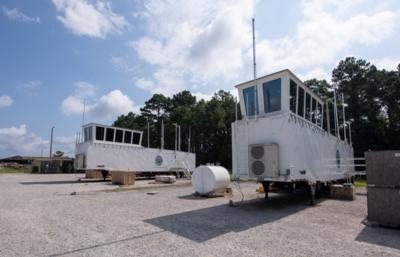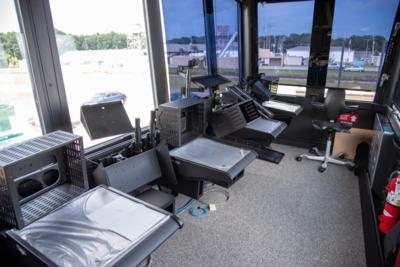Navy Plans To Roll Out Three LMATCT Platforms In Fiscal Year 2019
Space and Naval Warfare Systems Center (SSC) Atlantic engineers along with officials from the FAA and 437th Aerial Port Squadron conducted a test load of a large mobile air traffic control tower (LMATCT) onto a C-17 Globemaster III July 26 at the Joint Base Charleston - Air Base. The test represented a significant milestone between the FAA and SSC Atlantic in their collaborative efforts to roll out three LMATCT platforms by Fiscal Year 2019, replacing older models originally constructed in the 1990s.

"This test was a big step in our preparations to accept these mobile assets into the National Airspace System (NAS)," said Jeffrey Yarnell, FAA air traffic control facilities engineering director. "We are extremely pleased with our partnership with SPAWAR and the Air Force in this endeavor."
The new models, specifically designed to be transportable on military airlift, directly support the FAA's Mobile Asset Management Program (MAMP), which delivers mobile systems necessary to restore ATC capabilities during natural disasters, facility outages or when other permanent systems are out of service for upgrades.
In the time leading up to the loading test, the FAA asked SSC Atlantic to provide the integration and engineering support for the new towers due to their extensive background in deployable control centers. "SPAWAR has significant experience in developing deployable air traffic control assets for the military, which proved invaluable in supporting the design reviews during the design and fabrication of the LMATCTs," said Cassandra Leid, FAA's MAMP lead. "SPAWAR has the human resources and contracts with the program management, as well as the technical skills and experience to ensure that, at the completion of provisioning, the LMATCTs will be capable of fulfilling their mission."
Paul Drago, SSC Atlantic air traffic control special programs integrated project team lead, along with lead engineers Jim Spivey and Shawn Truesdale, provided the integration work and the engineering consulting to navigate the challenges of upgrading to a new model. "Working with the FAA MAMP office offered us the opportunity to leverage our warfighter skillsets with mobile/transportable ATC and aviation command and control (AC2) systems to non-tactical systems," said Drago. "These FAA systems are critical to supporting the NAS in the aftermath of natural or manmade disasters, making the influence of our engineering expertise in warfighter ATC and AC2 systems value added."

Electrical aspects, to include configuring how the towers would connect to generators, as well as the automatic transfer of generator power and shore power, were just a few of the technical areas where Spivey and Truesdale's engineering expertise proved to be instrumental. "From our perspective, integration takes on two levels," said Spivey. "You have to build the facility first, which was handled by a separate contractor for this project, and the SSC Atlantic team provided consultation during that design and build structure. Then with the shell of a facility, we integrated the electronics in them to make them functional."
Previous to the LMATCT development, older models were not compatible with military airlift, which proved to be challenging during natural disasters requiring expeditious delivery of command and control assets.
When a requirement arose in 2010 for a fifth wheel ATC tower to be delivered to Haiti following a devastating earthquake, the FAA's only timely transport option was to contract foreign airlift at the cost of $1 million. To overcome this limitation, the FAA and SSC Atlantic pursued a design that would meet the Air Transportability Test Loading Activity (ATTLA) certification requirements through Wright-Patterson Air Force Base, Ohio, which ensures cargo on Air Force aircraft is compatible and safe with the capabilities of the plane. "When you take a big heavy platform and put it on the plane, if they have to do tactical approaches, the equipment has to stay right there, it can't deform - that drove a lot of the requirements in constructing the tower," said Spivey.
Some of the features of the new towers include a framework designed to handle a 4.5g landing without distorting the chassis, as well as a cab that is capable of retracting into the body of the trailer, making it easily transportable on U.S. highways and on Air Force aircraft, Leid explained. With the new features in place, it was necessary for the Air Force's 437th APS to conduct a test load of the LMATCT on the C-17 with FAA and SSC Atlantic team members on site in order to validate the ATTLA certification and provide the assurance needed to finalize the towers for operational use. As part of the test, 437th APS personnel provided the knowledge and load team required to ensure the tower could be processed on the C-17 without damage to the aircraft, the system itself or injury to personnel assisting. "It's a great feeling knowing that we have the level of professionalism and expertise working in the Aerial Port to accomplish any mission," said Thomas Dybowski, 437th APS air cargo operations manager.
"This static load was critical to ensure this asset can be safely loaded and deployed when needed. There is a great sense of pride knowing we were part of that."
With the success of the aircraft load, the next step for the combined team is to make final modifications and test electronics prior to staging the towers in the next few months across the U.S. at established storage and deployment sites.
According to Leid, the FAA is establishing staging areas in Boise, Idaho, and Greensboro, North Carolina, as well as a deployment area in Independence, Missouri. The new systems will be housed within reasonable distances of potential deployment sites, while also keeping the towers out of any immediate danger of natural disasters and environmental events such as forest fires. "Once the LMATCTs are delivered," said Yarnell, "We can be confident that they can be quickly transported anywhere in North America that we might need these control towers."
SSC Atlantic provides systems engineering and acquisition to deliver information warfare capabilities to the naval, joint and national warfighter through the acquisition, development, integration, production, test, deployment, and sustainment of interoperable command, control, communication, computers, intelligence, surveillance, reconnaissance, cyber and information technology capabilities.
(Image provided with U.S. Navy news release)
 ANN's Daily Aero-Term (04.14.24): Maximum Authorized Altitude
ANN's Daily Aero-Term (04.14.24): Maximum Authorized Altitude ANN's Daily Aero-Linx (04.14.24)
ANN's Daily Aero-Linx (04.14.24) Classic Aero-TV: 'We're Surviving'-- Kyle Franklin Describes Airshow Life 2013
Classic Aero-TV: 'We're Surviving'-- Kyle Franklin Describes Airshow Life 2013 Aero-News: Quote of the Day (04.14.24)
Aero-News: Quote of the Day (04.14.24) Airborne 04.09.24: SnF24!, Piper-DeltaHawk!, Fisher Update, Junkers
Airborne 04.09.24: SnF24!, Piper-DeltaHawk!, Fisher Update, Junkers




